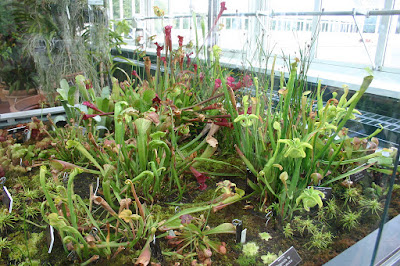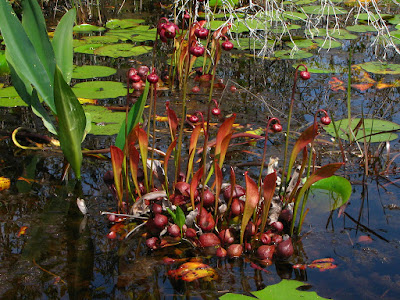Parrot pitcher plant is native to North America, in the Southeastern United States. It grow in wet savannas and pine flatwoods, seepage slopes, and bogs. Quite often the plants can be found near the waterline. They may occasionally be submerged. While submerged, it will capture water arthropods and tadpoles.
Parrot pitcher plant also called as Sarracenia psittacina, Sarracenia calceolata, Sarracenia pulchella, is a carnivorous plant of the genus Sarracenia. This species was described by Carl Linnaeus in 1753.
IDENTIFY PARROT PITCHER PLANT - SARRACENIA PSITTACINA
Parrot pitcher plant is native to North America, in the Southeastern United States. It grow in wet savannas and pine flatwoods, seepage slopes, and bogs. Quite often the plants can be found near the waterline. They may occasionally be submerged. While submerged, it will capture water arthropods and tadpoles.
Sarracenia psittacina is a perennial herb with leaves modified into tubular pitchers that are clustered into a rosette with outer whorl of pitchers typically resting on the ground, inner pitchers semi-erect. The pitchers are 8 - 30 cm long, with a large wing on the upper side and a deeply curved and inflated hood; the pitchers are green near the base and reddish near the top, with whitish, translucent patches on the upper pitcher and the hood.
This plant capture and digest insects and other small animals in their pitchers. Nectar is produced by glands around the top of the pitcher, luring animals to the opening with its sweet smell. Stiff, down-pointing hairs line the pitcher, encouraging the animals to slide in and impeding their escape. The whitish, translucent patches on the upper pitcher and the hood further confuse the insects after they have entered the pitcher. Enzymes dissolved in water in the base of the pitcher digest the animals, making nutrients, especially nitrogen, available for absorption by the plant. The small opening leading into the inflated hood of the parrot pitcher plant has led some observers to consider this plant’s trap more of a “lobster pot” than the typical “pitfall trap” of other pitcher plants. These traps work underwater, catching aquatic insects, an adaptation to the occasionally flooded habitat of the parrot pitcher plant.
Sarracenia psittacina blooms from March to May from the 15 - 35 cm tall, leafless flower stalk. Flower solitary with 5 drooping, maroon petals, 3 - 4 cm long; 5 sepals, maroon on the outside and green on the inside; and a yellow-green, umbrella-shaped style disk in the center of the flower. Sepals and style disk persist long after the petals fall, and the fruit – a round, warty capsule about 1.5 - 2 cm wide develops.
Some clone and varieties: Sarracenia psittacina var. psittacina (the flower is red, and the pitchers are variously pigmented; some are mostly green with red venation, others are deeply flushed red throughout); Sarracenia psittacina var. okefenokeensis (the pitcher is longer than about 30 cm).
PARROT PITCHER PLANT - SARRACENIA PSITTACINA CARE AND CULTURE
Cultural information should only be used as a guide, and should be to be adapted to suit you. Your physical location; where you grow your plants, how much time you have to devote to their care, and many other factors, will need to be taken into account. Only then can you decide on the cultural methods that best suit you and your plants.
Light and temperature:
Parrot pitcher plant enjoys being in a bright light spot. It need a temperature of 20 to 30 ° C in the summer , 5 to 15 ° C in the winter. This plant needs a seasonality to live long term. Get him a dormant period in winter of about 3 months. A house is too hot for this plant in winter. If you have cold winters, leave your plant outside. Only protect it from dry winds and periods of intense cold.
Substrate, growing media and repotting:
Take a 15 cm pot for an adult plant. You can use a soil composed of 70% blonde peat , 10% sand , 10% perlite and 10% vermiculite as substrate. During the potting, make a small dome which allows to always have the collar of the plant without too much moisture, and to clear well. Do not start watering too early, but as soon as the plant has a tendency to restart, do not hesitate to give it water again. This Sarracenia is a little capricious for the winter period. Repot during late winter and early spring for a robust plants in summer.
Watering:
In spring and autumn, hold the base of the pot permanently in a bottom of water. In winter , occasionally immerse your pot in a little rainwater.
Feeding:
Do not fertilize the plants. Kept outside, the plant will catch more than enough food for themselves. If you keep your plants indoors, you can feed them with dried insects every few weeks.
Propagation:
Parrot pitcher plant can be propagated by seed: Sow the seeds from harvest to fall, which is more prolific. Or keep the seeds in the bottom of the refrigerator until February. In moisture-saturated mini-greenhouses the fresh seeds take about three weeks, depending on the temperature for good germination. Seeds that have spent a few months in the refrigerator are sometimes longer to germinate. It is possible to repot the young seedlings at the end of the year, but it is better to wait until the following spring.
Sarracenia psittacina can also be propagated by division: It is certainly the most used method at Parrot pitcher plant , the division can be done at any time of the year. Division by rhizome division in September, with no apparent problem, but must redouble attention to the excess moisture.















COMMENTS